
Musee D’Orsay on the bank of the Seine River. This former railway station has a superior location on the Left Bank. Overlooking the Seine. It is near the Parliament, UNESCO and fine restaurants. Photo courtesy of Wikimedia Commons.
By Jacqueline Swartz
Whether it’s your first time, or you are returning, maybe for the umpteenth time, Paris seduces. What is it about this city that makes it one of the most visited places in the world? That makes people pull up stakes and move to the City of Light. What drew painters like Degas, Cezanne and the pantheon of Impressionists, and writers such as Hemingway? First the overwhelming visual beauty, both the grand monuments like Place de La Bastille, the opulent buildings and the narrow, winding streets.
There is architectural drama on both sides of the Seine River, with majestic buildings from the 18th and 19th centuries. And there are parks and gardens, like the Jardins de Luxembourg, with its sculpted flower beds and meandering paths. From here, the stroll along the river following rue de Seine is the most beautiful walk in the world, according to New Yorker writer, Adam Gopnik in his book, Paris to the Moon. We love Paris, he writes, for its cafes and churches, its markets and museums, which are not mere relics of a bygone age. “It is not antiquated Paris that we love, but the persistent, modern material Paris, carrying on in a time of postmodern immateriality, when everything seems about to dissolve into pixels. We love Paris not out of ‘nostalgia,’ but because we love the look of light on things, as opposed to the look of light from things, the world reduced to images radiating from screens.”
Paris has 20 arrondissements, or municipal districts; they follow a circular pattern emerging from a center. The city, it has been often noted, is like a group of villages, each with its own character. The oldest and most well-known are on the Left Bank. It has evolved from a medieval center of learning to a mecca for impecunious writers to the most expensive part of town.
And yet it has kept its aura – there’s a reason it still draws visitors and Parisians alike. “I love the way Paris seems never to change but is constantly in flux,” notes longtime Left Bank resident, Joseph Smallhoover, who practices international business law in Paris and Pittsburgh. Storefronts stay the same, he says, “but the shops and restaurants dance across time, if not space. A restaurant can be the place to go for a decade and then not for the next decade and then be rediscovered.”
One place that needs no rediscovery is Café de Flore. It’s located on Boulevard Saint Germain, one of the wide streets intersected by the more intimate side streets of this Left Bank quarter. Opened in 1880, the Art Deco-style hangout is where Simone de Beauvoir and Jean-Paul Sartre worked and held court. Today it’s the place to go for writers, journalists and philosophers. The overheard conversation can be as fascinating as the view of passersby from one of the many sidewalk tables. (Oddly enough, the most active place is on the charmless second floor, which has been compared to a Holiday Inn meeting room). The Flore even has its own literary prize, the Prix de Flore, given to “young and audacious” writers.
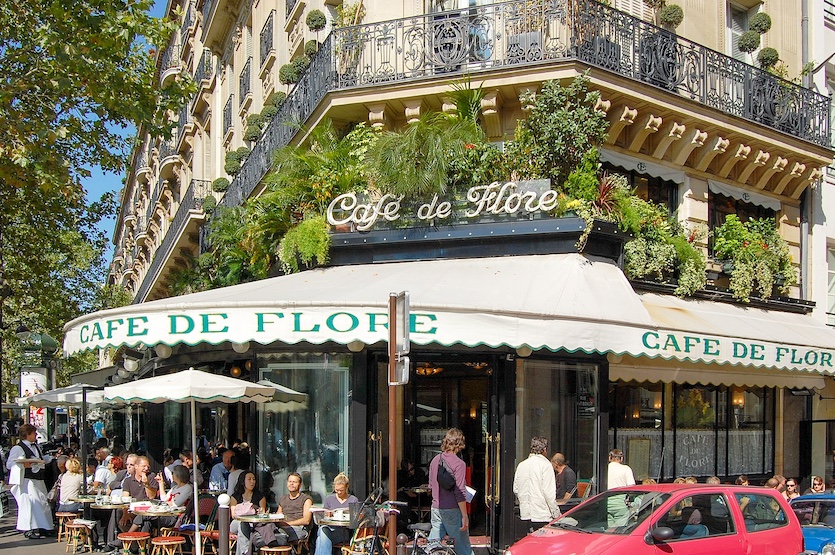
Cafe de Flore. The place where Simone de Beauvoir and Jean-Paul Sartre worked and socialized. While other historical cafes attract mainly tourists, the Flore still draws writers and philosophers. Photo courtesy of Wikimedia Commons
The old Left Bank is still alive in the legendary Shakespeare and Company, which sells English language new and used books. It opened in 1919, by Sylvia Beach, who published James Joyce’s Ulysses when nobody else would dare. Closed during the Occupation, it re-opened in 1951. The owner, George Whitman, welcomed writers including Anais Nin, William Styron, Lawrence Durrell and James Baldwin.
With its café, lectures and other events, it’s a hangout for visitors and American expats. It looms large in the 2024 book, The Paris Novel, by well-known food editor and novelist, Ruth Reichl. The main character even sleeps there – the store has a history of allowing struggling writers to sleep on its couches. The book takes place in 1983, yet most of the buildings and streets mentioned are still standing.
Another bookish experience is to stroll along the quais bordering the Seine. There you’ll find stalls, with bouquinistes selling used and antiquarian books, postcards etchings and other discoveries. The stalls have been there since the 1600s, and have survived revolutions, attempts to ban them and the German Occupation.
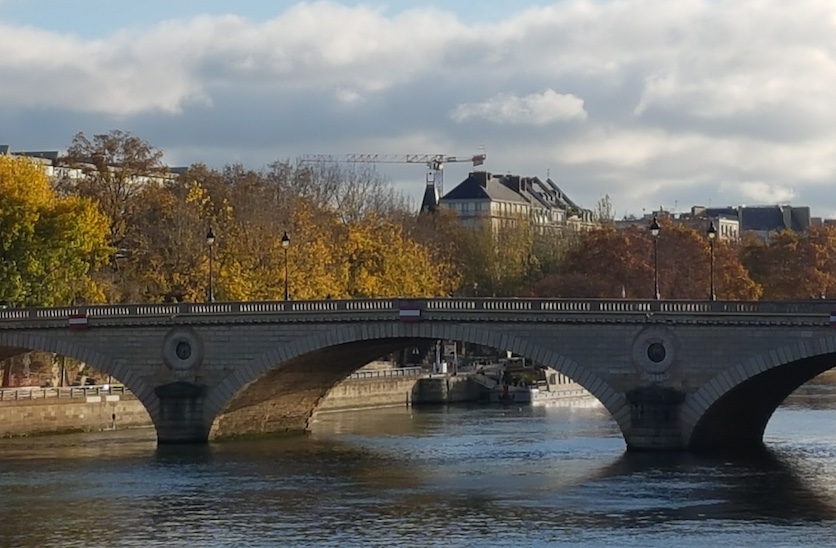
Crossing the Seine from left to right bank. A short walk that seems like an exciting journey. Photo by Jacqueline Swartz
Cuisine, Haute and Otherwise
France remained an agricultural country long after England underwent the Industrial Revolution. Here farm to table is nothing new – in fact, it is more important than ever in these fast-food times – and the outdoor markets make you wish you had a kitchen. I remember walking past a stall selling three kinds of billowy lettuce and feeling a strong urge to make a salad. I also had to resist the small, sweet strawberries, which would not last the day crushed in my purse.
Every region of France has its specialties. But in Paris, you can find them all – dozens of cheeses, wines, classic dishes like boeuf en daube, sauces, fish, classic desserts like the upside-down apple tarte tatin.
Every arrondissement has its eateries, from traditional to Michelin-starred, from to pop-ups and sandwich shops. For an up-to-date rundown, go to the website, Eater.com
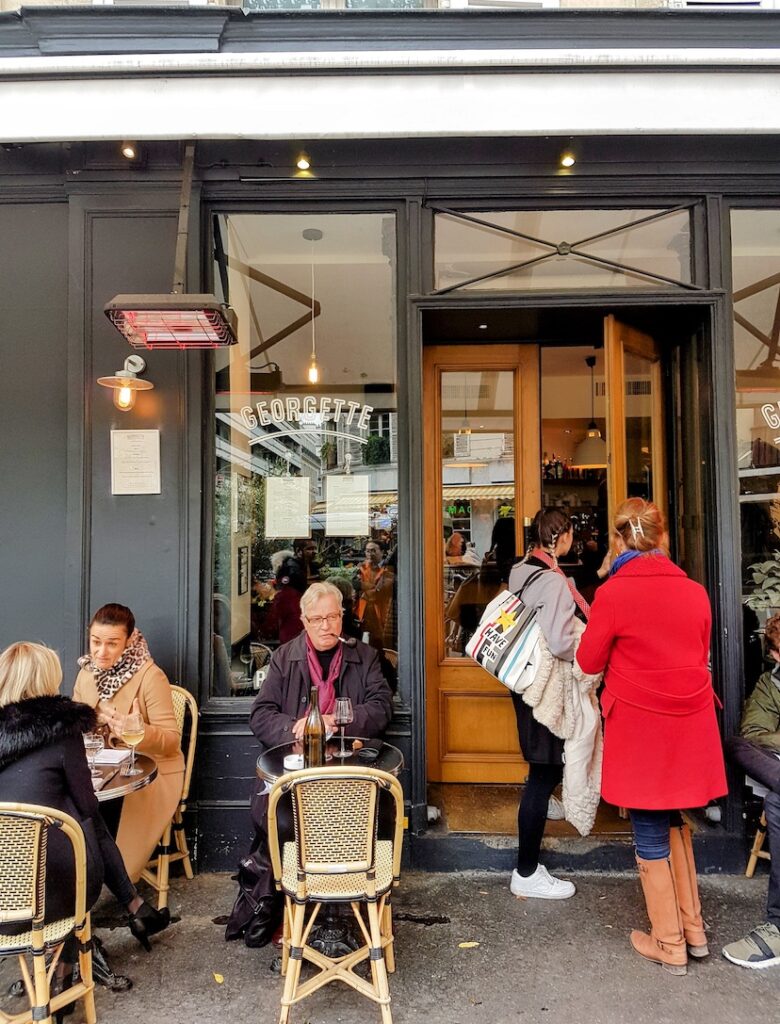
Restaurant Georgette serves what it calls traditional cuisine revisited. The outdoor area is popular with locals and tourists alike. Indoors is a chic restaurant that carries France’s “Maitre Restaurateur” designation for quality chefs and seasonable products. Photo by Jacqueline Swartz
On the Left Bank, I had lunch at Restaurant Georgette, in the 6th district. The salad of artichokes and mushrooms, arugula, sesame seeds and almonds was inventive and delicious. The sea bream with red cabbage was succulent. Then the dessert: Iles Flottant, or Floating Islands. Dense clouds of poached meringue float on vanilla custard. It’s a classic not often found.
There was a time when French food was almost all you could get. Now there are Middle Eastern, Thai, Japanese and Mexican restaurants that serve seriously good food. Following the scandal of restaurants serving reheated frozen foods, some restaurants now announce that their food is local and prepared on-site.
Crossing the Bridge when You Come to It – The Pont Neuf and Notre Dame
Crossing the bridges along the Seine is an odd thrill, like crossing the border to another country in a few minutes. Everything is the same, but different. On the walk over the squat stone of the Pont Neuf bridge, inaugurated by Henri IV in 1607, you can stop off at the Isle Saint Louis, where the Notre Dame de Paris Cathedral stands as it is being meticulously renovated after a 2019 fire. The cathedral, built between the 12th and 14th centuries, is a model of Gothic architecture, with spires and turrets. Fortunately, the fire spared the interior, with its soaring nave and rose windows.
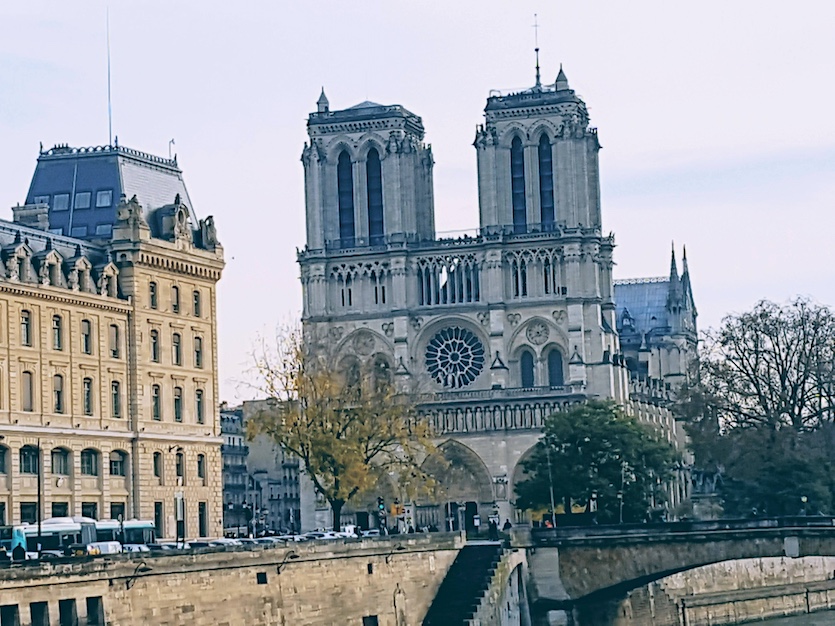
Notre-Dame, Paris’ most venerated cathedral, stands on the Isle Saint-Lous. Built between the 12th and 14th centuries its Gothic architecture features spires and soaring turrets. A 2019 fire left the interior intact. Photo by Jacqueline Swartz
Notre-Dame Cathedral has been the location of major events, from the coronation of Napoleon Bonaparte in 1804 to the liberation of Paris in 1944. Today, people come to watch the renovations, and there is a space that tells you of their progress.
A ten minute walk leads to another gothic masterpiece, Saint-Chapelle. Completed in 1248, the chapel is located in what was a royal palace but is now the law courts. Smaller and more intimate than Notre Dame, its luminous arching stained glass windows depict scenes from the Old and New Testament in a symphony of light and color.
Musee D’Orsay – First Impressionists
Still on the Left Bank is a cathedral of art, the Musee D’Orsay. The former railway station, which opened as a museum in 1986 has the largest collection in the world of Impressionist paintings. A special exhibit marks the 150th-year celebration of the Impressionist superstars, from Manet to Monet, from Renoir to Cezanne. Oddly enough, you have to take the escalators to see them. The first floors are devoted to the very official grandiose paintings that were acceptable at the time. The official Paris Royal Academy scorned the Impressionists, who took their easels outdoors to paint nature, such as Monet’s Water Lilies, and showed middle and lower-class subjects like Danse a la campagne (Dance in the Country), by Pierre-August Renoir and Dejeuner Sur l’Herbe, by Eduard Manet, which features a nude woman and clothed men having a picnic on the grass.

Musee D’Orsay visitors look at the painting “Dejeuner sur l’herbe” by Eduard Manet. The painting shocked the art establishment because the nude woman sat among dressed men, and in a way that did not refer to mythology, like nudes in the past. The museum has the largest collection of Impressionist paintings in the world, and 2024 marks 150 years since it began. Photo by Soephie Crepy
Where to See the Eiffel Tower
The Eiffel Tower opened for the 1889 Expo and marked the 100th anniversary of the French Revolution. It was completed in little over two years after ground was broken, and the tower quickly became the lodestar of Paris. But climbing it can be expensive (a ticket to the top by lift costs 35 euros for adults, 15 for youth aged 12-24 and 8.90 for children under 11. You will likely need a reservation. So why not opt for high places in Paris that offer breathtaking views of the tower.
The Musee du Quai Branly was designed to display the indigenous art and cultures of Africa, Asia, and the Americas. Situated along the Seine river, the museum has a collection of over 300,000 well-displayed objects and is well worth a visit.
The rooftop restaurant, Les Ombres, offers gourmet food and a spectacular view of the Eiffel Tower. Starchitect Jean Nouvel designed it, down to the dishes. The rounded space is capped by a domed ceiling, with ironwork that’s supposed to echo the Eiffel Tower just beyond.
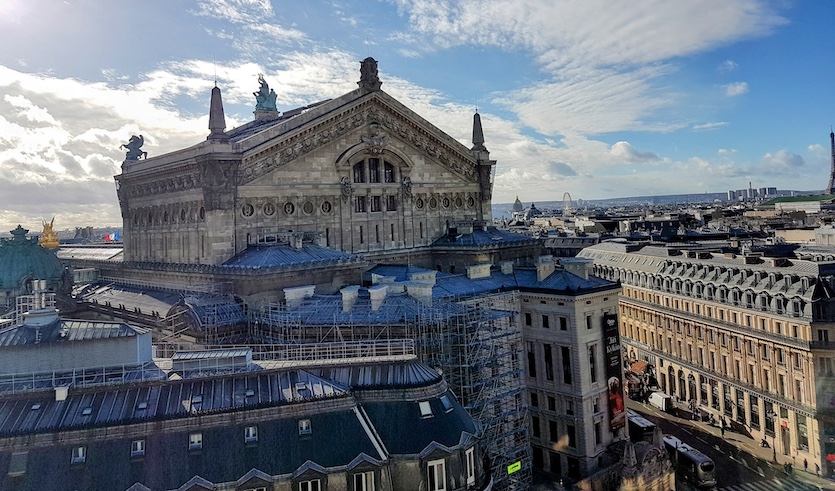
Opera Garnier. Known as the Palais Garnier, it was built from 1861 to 1865, a time when opulent buildings like the Galleries Lafayette were erected. The style is borrowed from the Baroque and Renaissance architecture. The facade and the interior left almost no space without decoration. The facade used marble frieze and statuary from Greek mythology. Inside is a grand staircase made of marble. Opera Garnier houses the Paris Opera Library Museum. Photo by Jacqueline Swartz
Another place to view the tower is the Galleries Lafayette. The department store, one of the great late 19th-century Parisian buildings, is famous for its steel-frame Art Nouveau glass dome and its eight-story cupola. It’s also one of the city’s best places to shop. Within the historic 750,000 square feet of retail space, you’ll find every luxury brand imaginable, plus emerging designers and vintage boutiques. There are restaurants and cafes, including one on the roof that offers a jaw-dropping view of the Eiffel Tower, as well as the Opera Garnier and Notre Dame Cathedral.
The Right Bank
The Right Bank is the place to see France’s imperial splendor. There’s the Place de la Concorde, with the obelisk Napoleon brought back from Egypt. And, of course, the Le Louvre, a royal palace before it became a museum. These days, it’s a good idea to make a reservation. Book a ticket, but don’t think you can see the whole collection in one visit. Choose an era or an artist. One example: a whole room of floor-to-ceiling paintings by the Flemish artist, Rubens (1577-1639), an opulent fleshy matriarchy of bejeweled royals and their barefoot attendants. No fat shaming here.
Montmartre and Below
Can-can dancers and red windmills, struggling artists and hillside hangouts – Montmartre evokes La Vie Boheme when the arts burst open on the streets of Paris. As late as 1860, the hilltop village of Montmartre was not part of Paris but a semi-rural area with cheap rents. There was (and still is) a vineyard, and the famous red windmill gave the area its signature look. If the Left Bank was a haunt for writers, Montmartre drew visual artists who frequented places such as the Moulin Rouge, where Henri de Toulouse-Lautrec painted can-can dancers and sad onlookers. The posters he created as the club’s publicist, still remain. At the Chat Noir (Black Cat) cabaret, Eric Satie was the house pianist. It lasted a dozen years, until 1895. Another famous hangout, the Lapin Agile is still open and offers jazz and the songs popularized by Edith Piaf and other classic French singers.
Gone are the days when Montmartre was the place where Picasso set up his easel. Today, there are street artists on Place du Tertre, where tourists come to get their portraits or caricatures done. Those in the know hang on to their phones and wallets, for this place is known for its pickpockets. And yet….there’s no place like Montmartre to get the feeling that you’re seeing the old Paris, with all its cliches. When choosing a cafe or restaurant, go to the less-touristy side streets.
At the top of Montmartre, is the Sacre-Coeur Basilica. Its white dome offers a breathtaking panoramic view of the city. The Basilica, built in a Byzantine-Romanesque style, took forty years to construct and was opened in 1919, after Word War 1. It offers religious retreats and tours. Inside there are almost 300 steps to get to the top of the dome.

The hilltop village of Montmartre has an exciting past. During the Belle Époque, it became a haven for artists such as Toulouse-Lautrec, Maurice Utrillo, Van Gogh, and Picasso thanks to its more affordable cost of living and cheap wine (it was exempt from Paris’s wine tax)! Here, an artistic community was formed, and a lively cabaret culture flourished. Today, you’ll find artists covering every square inch of the Place du Tertre in the center of the neighborhood, selling their canvases and offering portrait sessions. Photo courtesy of Paris Perfect
Pigalle
Walk down the rue des Abbesses and will you come to Pigalle. The well-known red-light district is becoming cool these days, with hipster hangouts competing with the old seedy sex shops and overpriced bars.
In what is now called lower Pigalle, Rue des Martyrs is considered one of Paris’ most charming streets. It used to be a place where writers and painters hung out, many spending the cocktail hour getting high on absinthe.
Today, it is dotted with some 200 cafes, cheese stores, boutiques and other small shops, with the whiff of bakeries a common scent. It’s a real neighborhood, with food markets and hardware stores. Former New Yorker bureau chief Elaine Sciolino, wrote a book about the street, noting that she could never be sad on the rue des Martyrs.
Le Marais
Paris has no more beautiful square than Place des Vosges, with its arcades, fountains and gardens. Built in the 17th century, in the spirit of the Italian and French Renaissance, it is the first planned public square in Paris. Yet “public” meant mostly the aristocracy, such as countess Madame de Sevigne, famed for her literary letters. Victor Hugo also lived there, in a small apartment which is now a museum. The arcades house upscale boutiques and some contemporary art galleries. The Hotel Pavillion de la Reine has a small sign, a private courtyard and royal prices.
The less grand but equally picturesque part of the Marais, with its narrow cobblestone streets, attracted Jewish immigrants from Eastern Europe, and the Rue des Rosiers is still known for some of the best falafel in Paris.
Nearby is au Petit Versailles du Marais Boulangerie, which won second prize for the best baguette in Paris. You can also find clothing stores with moderate prices. All over Paris there are discount boutiques with the name “stock”, meaning overstock. And savvy shoppers should check out the city’s many vintage stores.
The Picasso Museum is one of the major attractions of the Marais and in recent years has doubled in size by including Picasso’s own collection.
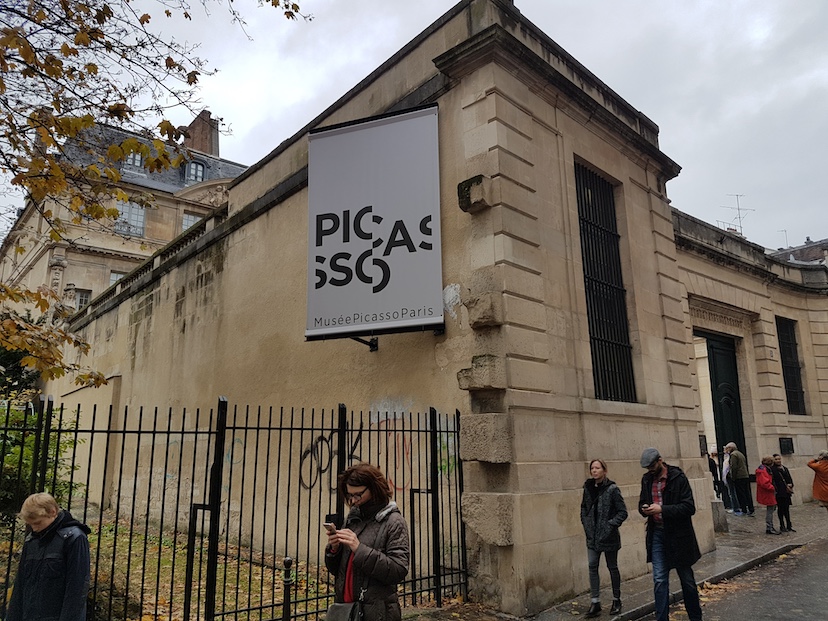
The Picasso Museum has the world’s richest collection of Picasso’s paintings, sculptures, illustrations, notebooks, photographs, and films. In 1973, his private collection was donated It included African masks, paintings by Cezanne and Matisse plus drawings by Degas and Giacometti. Photograph by Jacqueline Swartz.
In Paris, there’s a museum for everything, from coins to romance. Musee Carnevalet is dedicated to the city itself. The oldest museum in Paris, it was renovated in 2021 and occupies two 16th and 17th-century mansions. It begins in Gallo-Roman and medieval archeological and architectural collections, to items from the Revolution. Everything Parisian, it seems, is here, from Proust’s bedroom to paintings, sculptures and furniture. One popular attraction is an entire Art Nouveau jewelry store. Take a break at the Fabula restaurant, located in the museum’s courtyard.
Why Paris? The buildings, streets, neighborhoods, history, restaurants, cafes – all add up to a varied and compelling backdrop for your personal drama. It’s your movie. Whether you’re feeling sad, elated, pensive or curious, you are the main character. Paris is personal. If you’re lucky enough to visit, Paris can be yours.![]()
From her base in Toronto, Jacqueline Swartz has written about a broad range of French topics. Her recent contributions to EWNS include an examination of San Francisco’s French roots and an exploration of the Mediterranean region of Sete.

